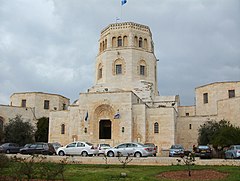Rockefeller Museum

The Rockefeller Archaeological Museum in Jerusalem is one of the largest and oldest archaeological museums in Israel and is located just outside northeast of the Old City . It was opened in 1938 under the name Palestine Archaeological Museum and renamed in 1967 after the Six Day War . It houses an extensive collection of artifacts found in what was then Ottoman Palestine since the 19th century . The museum is now a branch of the larger Israel Museum .
history
The museum was initiated in 1925 by James Henry Breasted , the founder and director of the Oriental Institute at the University of Chicago , and built over an eight-year construction period (1930–1938) with the financial support of John D. Rockefeller - he donated two million dollars. The white limestone building was designed by the British architect Austen Harrison in the neo-Gothic style and combines both western and eastern elements. The museum concept was designed by Harrison together with Eric Gill , a well-known contemporary designer.
The opening took place on January 13, 1938. The politician and historian Aref al-Aref (appointed in 1963) is one of the well-known directors .
In 1966 the museum was nationalized by King Hussein of Jordan, until then it was administered by an international board of trustees . During the Six Day War , control of the museum passed into Israeli hands; it was occupied by Israeli soldiers, the octagonal tower used as a lookout tower. After fierce fighting in this area, the Israelis ultimately triumphed, with the museum being transferred to Israeli administration.
meaning
The museum was the first to systematically collect the finds from the Holy Land and still has significant finds, such as wooden panels from the Al-Aqsa mosque from the 8th century and marble keystones from the Church of the Holy Sepulcher .
Overview
Tower hall
In the tower hall you can see a cross-section of the long settlement period in Palestine, from the Stone Age (gazelle torso - approx. 12,000 BC) to the 18th century.
South gallery
In the southern octagon you can see Mesopotamian and Egyptian pieces, most of which were found in Bet She'an . A special find is a stele of Pharaoh Sethos I.
The south gallery contains finds from the Stone Age to the Bronze Age, such as skulls, alabaster vessels, jewelry and statues, as well as the woodwork from the Al-Aksa mosque.
West gallery
Finds from the Hisham Palace, which the Umayyad caliph Hisham built near Jericho in 724 , are exhibited here, which represent the high art of early Islamic works.
Antique finds from Roman times are kept in the jewel hall, the oldest exhibits are 2000 years old. In the north area there are exhibits from the time of the crusaders.
North gallery
A reconstruction of an approximately 3,600 year old Hyksos grave from Jericho can be seen here, as well as a collection from the Iron Age from the 12th century BC. Glassware from the Roman era can be found alongside clay amphorae and clay figures. Glasses, fittings and door knockers as well as oil lamps and gold jewelry can be seen from the Byzantine period.
In the northern octagon are Jewish objects, including a mosaic from the synagogue of En Gedi .
Gravestone from Nablus - 2nd to 3rd centuries AD
4Q122 , fragment of a Dead Sea scroll from the 2nd century BC. Chr.
literature
- Baedeker , Allianz travel guide Israel-Palestine. 12th edition, 2010, ISBN 978-3-8297-1191-3 , p. 309.
Web links
- Homepage
- Rockefeller Museum . In: Israelmagazin.de
- Rockefeller Museum . In: gojerusalem.de
- Rockefeller Museum . In: jewishvirtuallibrary.org (English)
Coordinates: 31 ° 47 ′ 3.8 " N , 35 ° 14 ′ 9.1" E




